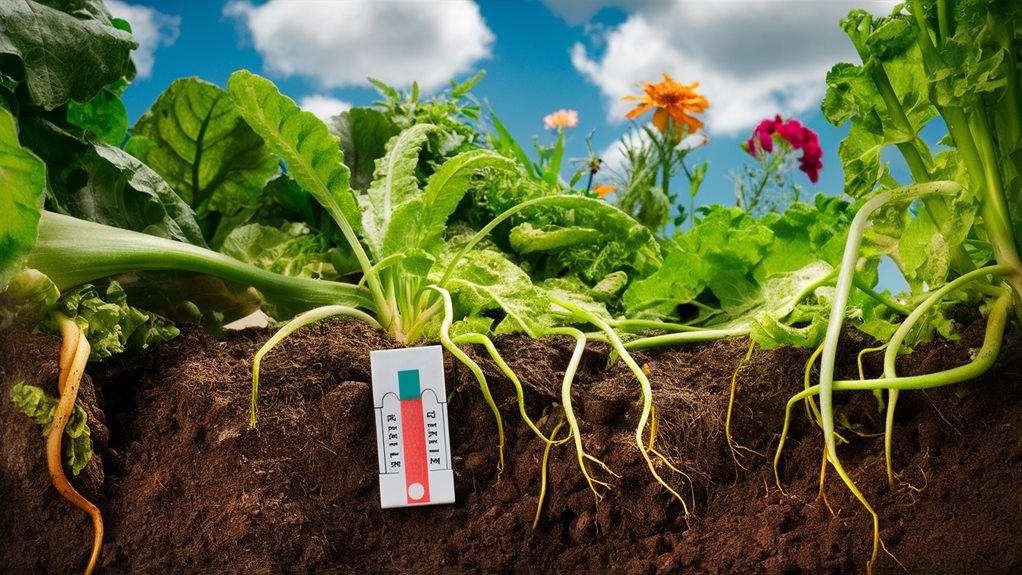Understanding soil pH is essential for your plants' growth, as it directly impacts nutrient availability and root development. Most plants prefer a pH between 6.0 and 7.0, where essential nutrients, like nitrogen and phosphorus, are readily accessible. If your soil is too acidic or alkaline, it might hinder your plants from absorbing crucial nutrients, leading to deficiencies. Regular pH testing allows you to make necessary adjustments, such as adding lime or sulfur to balance the pH. This knowledge empowers you to foster a healthy environment, promoting ideal growth and resilience in your garden's ecosystem. There's much more to explore on this topic.
Key Takeaways
- Soil pH directly influences nutrient availability, impacting plant growth and health.
- Most plants thrive in a pH range of 6.0 to 7.0, promoting optimal nutrient uptake.
- Acidic soils can hinder essential nutrient absorption, particularly phosphorus, affecting plant vitality.
- Regular soil pH testing helps make informed decisions to adjust pH for better plant growth.
- Proper pH balance enhances microbial activity, crucial for nutrient cycling and soil health.
Understanding Soil Ph
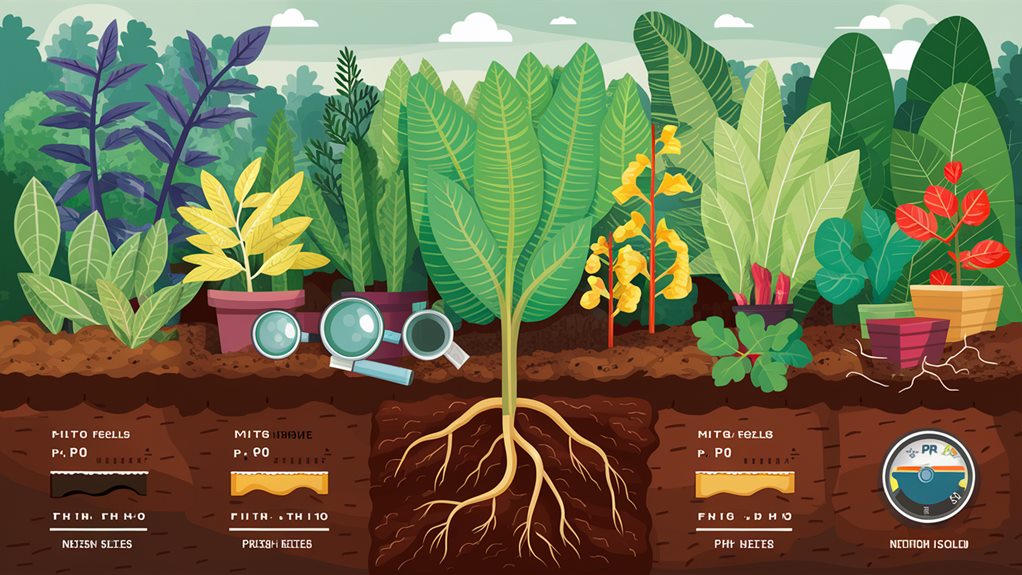
Soil pH serves as a crucial indicator of the chemical environment that affects plant growth. When you understand the nuances of pH balance, you can make informed decisions that enhance plant health in your garden or agricultural setting.
Soil pH ranges from 0 to 14, with values below 7 indicating acidity and above 7 signifying alkalinity. Most plants thrive in a slightly acidic to neutral range, typically between 6.0 and 7.0. Maintaining the proper pH is particularly important for herb gardens, as nutrient-rich soil fosters strong roots and healthy plants.
Monitoring your soil's pH gives you insights into nutrient availability and microbial activity, both crucial for robust plant growth. If the pH is too low or too high, it can hinder the absorption of essential nutrients, leading to deficiencies and stunted growth.
You'll find that adjusting pH can be accomplished through the addition of lime to raise it or sulfur to lower it.
Effects of Ph on Nutrients
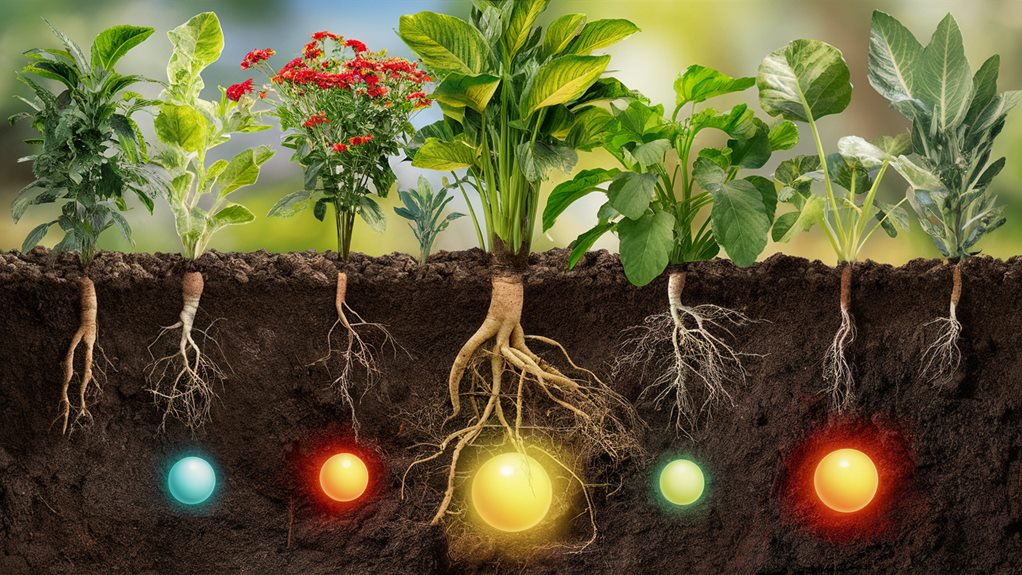
pH greatly influences nutrient availability in the soil, directly impacting plant health and growth. When you comprehend how pH levels affect nutrients, you can better support best plant development. For example, using organic fertilizers can help counteract some pH imbalances by enriching the soil with essential nutrients. Here's how varying pH levels can make a difference:
- Acidic Soils (pH < 6)**: In these conditions, essential nutrients like phosphorus become less available, leading to stunted growth.
- Neutral Soils (pH 6-7): This range is ideal for most plants, allowing for maximum nutrient uptake, including nitrogen, potassium, and magnesium.
- Alkaline Soils (pH > 7)**: Nutrient deficiencies, particularly of iron and manganese, can occur, causing chlorosis and hindering plant vitality.
Understanding these effects will empower you to adjust your soil's pH, ensuring that nutrients are accessible for best growth. Regular soil testing is vital to monitor pH levels and make informed decisions about amendments.
Soil Microbial Activity
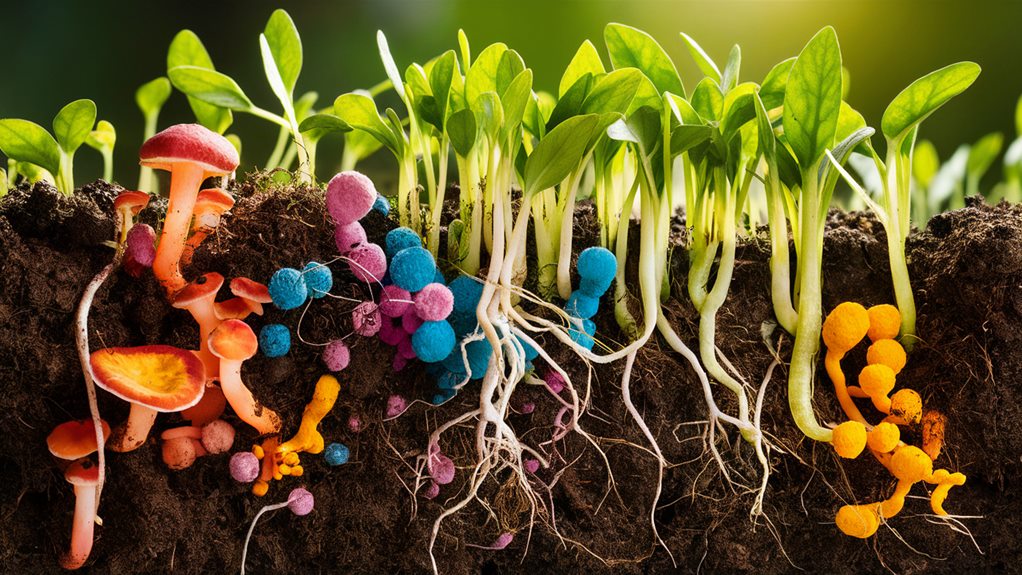
Microbial activity plays an important role in maintaining soil health and supporting plant growth. The diversity of microorganisms in the soil greatly impacts nutrient availability and organic matter decomposition, which is crucial for sustainable gardening practices. High microbial diversity promotes a more resilient ecosystem, enhancing the soil's ability to respond to environmental stresses.
When you consider the relationship between plants and soil microbes, it's evident that this plant symbiosis is key. Mycorrhizal fungi, for instance, form beneficial associations with plant roots, extending their reach to absorb water and essential nutrients like phosphorus and nitrogen. Additionally, using tools such as soil moisture meters can help monitor moisture levels, ensuring ideal conditions for microbial activity.
Moreover, these microbes are essential in facilitating nutrient cycling. When organic matter breaks down, microbes release nutrients in forms that plants can readily absorb. This interaction not only boosts plant health but also enhances crop yields.
Optimal Ph Ranges
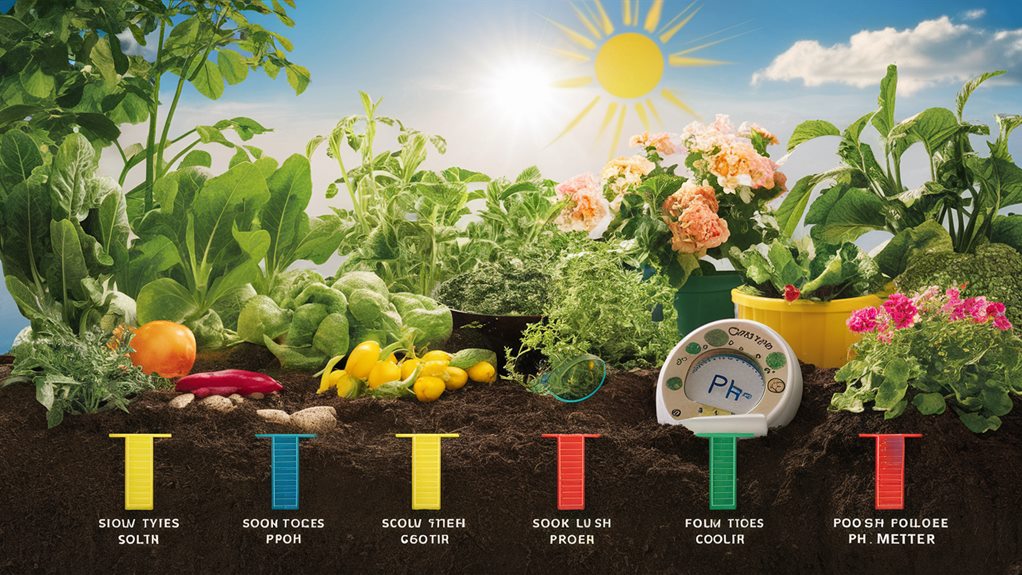
In the field of plant growth, understanding the most suitable pH ranges is crucial for maximizing nutrient availability and supporting strong development. Plants thrive in specific pH environments that greatly influence their nutrient uptake, root development, and overall productivity.
Here are the ideal pH ranges for different types of plants:
- Acidic soils (pH 5.0 – 6.0): Ideal for crops like blueberries and azaleas, where plant adaptation to lower pH enhances nutrient absorption.
- Neutral soils (pH 6.0 – 7.0): Most vegetables and grains flourish here, promoting robust root development and efficient nutrient uptake.
- Alkaline soils (pH 7.0 – 8.0): Certain plants, such as asparagus and lavender, can thrive, but nutrient availability may be restricted.
Testing Soil Ph
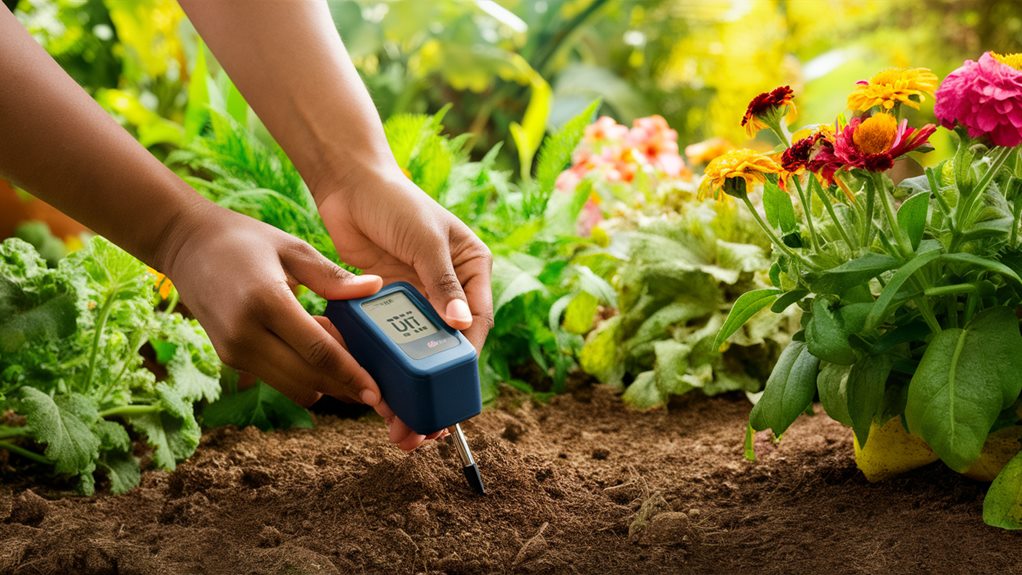
To maximize plant growth, accurately testing soil pH is crucial for evaluating nutrient availability and soil health. Understanding the pH level helps you determine which nutrients are accessible to your plants. A pH meter is the most reliable tool for this task, providing quick and precise measurements. However, you must guarantee pH meter accuracy by calibrating it regularly with standard solutions. This step is essential because even a slight deviation can lead to incorrect assessments of soil conditions.
When you test soil pH, collect samples from various locations in your garden or field to get a thorough view of the overall soil profile. Aim to test at different depths, as pH can vary significantly. After collecting your samples, follow the pH meter's instructions carefully for the best results.
In addition to using a pH meter, consider other testing methods, such as pH test strips or chemical kits, if you're looking for alternatives. However, remember that these methods mightn't offer the same level of precision. Ultimately, knowing your soil's pH is vital to optimizing its potential and ensuring ideal nutrient availability for your plants.
Adjusting Soil Ph Levels
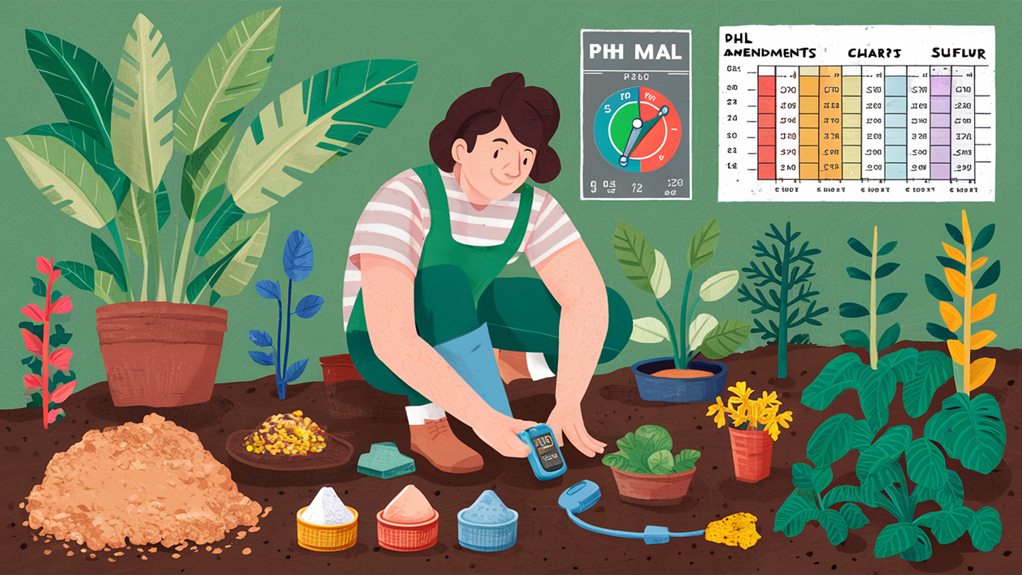
Once you've tested your soil pH and identified its current level, adjusting it becomes the next critical step to enhance plant growth. Effective pH management is crucial, especially if you're dealing with acidic soils, as these conditions can hinder nutrient availability. Here's how to adjust your soil pH effectively:
- Add Lime: If your soil is too acidic (below 6.0), incorporating agricultural lime can raise the pH. This process not only neutralizes acidity but also adds calcium, which is beneficial for plant health.
- Use Sulfur: Conversely, if your soil pH is too high (above 7.0), elemental sulfur can lower it. This process takes time, so be patient and monitor your changes closely.
- Organic Matter: Adding compost or well-rotted manure can improve soil structure and help buffer pH levels, promoting a more balanced environment for plant roots.
Long-term Soil Health

Long-term soil health is necessary for sustaining productive plant growth and securing ecosystem stability. You need to take into account how soil acidity affects your plants over time. High acidity can impede nutrient availability, leading to poor plant response. Regular monitoring of soil pH helps you identify imbalances that may arise from excessive fertilization or organic matter decomposition.
In managing soil health, it's important to adopt practices that improve both pH and structure. Crop rotation, cover cropping, and reduced tillage can enhance microbial activity, which in turn stabilizes pH levels and promotes a favorable environment for root development.
Additionally, incorporating organic amendments like compost not only buffers soil acidity but also enriches it with essential nutrients. This holistic approach ensures that your soil remains alive and responsive, fostering a productive ecosystem.
You'll find that by prioritizing long-term soil health, you create an environment where plants can thrive, leading to better yields and sustainable practices. When you invest in soil health, you're investing in the future of your garden or farm, ultimately contributing to a more resilient agricultural landscape.
Frequently Asked Questions
How Does Soil Ph Affect Different Plant Species?
Soil pH plays an important role in crop selection, as different plant species thrive in varied pH levels. You'll find that some plants prefer acidic soil, while others flourish in neutral or alkaline conditions. If you're cultivating crops, understanding these preferences helps maximize yield.
For instance, blueberries thrive in acidic soil, whereas most vegetables prefer a more neutral pH. Adjusting soil pH can greatly impact your success in growing diverse plant species effectively.
Can Ph Fluctuations Harm Established Plants?
Yes, pH fluctuations can harm established plants. When pH stability is compromised, plants often experience increased stress, limiting nutrient availability and affecting overall health.
You'll notice symptoms like wilting or yellowing leaves as plants struggle to adapt. These fluctuations can disrupt beneficial microbial communities in the soil, further exacerbating plant stress.
Monitoring soil pH regularly guarantees a stable environment, allowing your plants to thrive and maintain their vigor amidst potential challenges.
What Is the Role of Organic Matter in Soil Ph?
Organic matter plays a vital role in regulating soil pH, which directly affects nutrient availability for plants. It enhances microbial activity, creating a lively ecosystem that breaks down nutrients into forms plants can absorb.
As organic matter decomposes, it can buffer pH fluctuations, promoting a stable environment for roots. This stability helps maximize nutrient uptake, ensuring your plants thrive.
Are Ph Levels the Same Across Different Soil Types?
PH levels aren't the same across different soil types due to variations in soil composition. For instance, sandy soils often have lower acidity compared to clay soils, which can retain more nutrients. This difference affects nutrient availability, impacting plant health.
How Does Climate Influence Soil Ph Over Time?
As the saying goes, "you reap what you sow." Climate plays a pivotal role in shaping soil pH over time, with regional variations leading to different levels of soil acidity. Changes in temperature and precipitation can notably impact these long-term trends, altering how organic matter decomposes and nutrients are released. Understanding these climate impacts helps you appreciate the dynamic relationship between environmental factors and soil chemistry, fostering a deeper connection to your landscape.
Conclusion
In the garden of plant growth, soil pH serves as the compass guiding nutrient availability and microbial harmony. By understanding and adjusting these levels, you're not just cultivating plants; you're nurturing a flourishing ecosystem. Think of ideal pH as the sweet spot where roots take deep breaths, and in turn, thrive. Regular testing maintains you keep this delicate balance intact, fostering long-term soil health and vibrant growth. Embrace the science, and watch your garden transform into a lush paradise.

